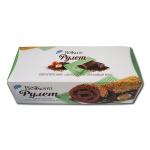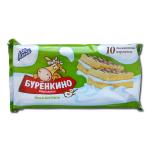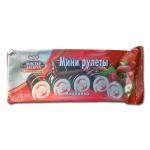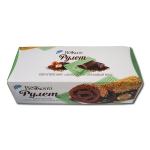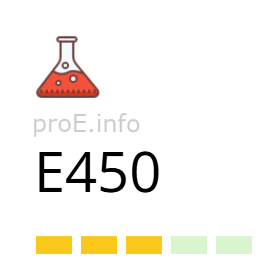
Other names for the additive (synonyms)
General Information
Pyrophosphates refer to a group of additives classified under E450 — salts and esters of pyrophosphoric acid. The general chemical formula of pyrophosphates is: P2O74−.
In the international food additive classification and numbering system, there are nine types of pyrophosphates used in food production. Each specific type of E450 additive is indicated by a Roman numeral subscript:
- E450(i) – Disodium diphosphate
- E450(ii) – Trisodium diphosphate
- E450(iii) – Tetrasodium pyrophosphate
- E450(iv) – Dipotassium diphosphate
- E450(v) – Tetrapotassium diphosphate
- E450(vi) – Dicalcium diphosphate
- E450(vii) – Calcium dihydrogen diphosphate
- E450(viii) – Dimagnesium pyrophosphate
- E450(ix) – Magnesium dihydrogen diphosphate
These compounds are produced using orthophosphoric acid (H₃PO₄) in reactions with hydroxides or oxides of metals such as sodium hydroxide (NaOH), potassium hydroxide (KOH), calcium oxide (CaO), calcium hydroxide (Ca(OH)₂), or magnesium oxide (MgO). The resulting orthophosphate salts (hydroorthophosphates) are then dehydrated—heated to remove water—yielding pyrophosphates, which are salts of diphosphoric acid (H₄P₂O₇).
Each type of pyrophosphate has specific properties. Sodium and potassium pyrophosphates (E450(i–v)) are widely used as emulsifiers, stabilizers, and moisture-retaining agents in meat and fish products. They help retain juiciness, improve texture, and prevent sediment formation.
Calcium and magnesium pyrophosphates (E450(vi–ix)) are more commonly used as leavening agents in bakery and confectionery goods, as well as sources of calcium and magnesium in functional foods. Pyrophosphates may also act as buffering agents to stabilize pH and enhance interactions with proteins or metal ions.
Potassium and sodium pyrophosphates are water-soluble but insoluble in alcohol. Calcium pyrophosphates are insoluble in water but dissolve well in hydrochloric and nitric acid.
Main characteristics of additive E450:
- Color – white, transparent.
- Odor – neutral.
- Taste – slightly acidic.
- Consistency – granules or fine to medium crystalline powder.
Effects on the Body
Risks of additive E450
Short-term excessive intake of pyrophosphates may cause stomach upset and gastrointestinal issues. In cosmetic products, pyrophosphates can trigger allergic skin rashes and irritation of mucous membranes.
Several studies suggest that chronic overconsumption of phosphate additives may lead to the following side effects:
- Hyperphosphatemia (elevated blood phosphate levels)
Excess phosphate intake can lead to accumulation in the bloodstream, disrupting mineral balance and potentially causing systemic complications. - Vascular and arterial calcification
Phosphates promote calcium deposits in blood vessel walls, reducing their elasticity and increasing the risk of atherosclerosis and coronary heart disease. - Increased risk of cardiovascular disease
Elevated phosphate levels are associated with higher rates of cardiovascular events, including heart attacks and heart failure — even in individuals without kidney disease. - Increased overall mortality (including among healthy individuals)
Epidemiological studies have linked even “high-normal” phosphate levels with elevated all-cause mortality, particularly in people with heart conditions. - Disrupted calcium-phosphorus metabolism
Excess phosphorus interferes with calcium absorption and metabolism, potentially leading to calcium depletion in bones and deposition in soft tissues. - Increased kidney load
The kidneys must work harder to excrete surplus phosphates, posing risks especially for individuals with chronic kidney disease (CKD). - Joint disorders (including pyrophosphate arthropathy)
Calcium pyrophosphate crystal deposition in joint tissues can cause inflammation and pain — a condition similar to gout, known as pseudogout or CPPD disease. - Osteoporosis due to calcium-phosphorus imbalance
An imbalance between calcium and phosphorus may leach calcium from bones, weakening their structure and increasing fracture risk. - Elevated LDL (“bad”) cholesterol levels
Research suggests a correlation between high phosphate intake and increased LDL cholesterol, contributing to plaque buildup and heightened stroke/heart attack risk. - Calcium-phosphate deposits in kidneys
Undigested phosphate-calcium complexes may accumulate in kidneys, leading to kidney stones and increasing the risk of renal failure and osteoporosis.
In 2019, the EFSA Panel on Food Additives and Flavourings re-evaluated the safety of phosphates, including E450 pyrophosphates. They established an Acceptable Daily Intake (ADI) of 40 mg/kg of body weight (as phosphorus equivalent). The panel raised concerns about excessive intake in children and recommended revising permitted levels in commonly consumed foods. They also emphasized the need to monitor phosphate intake in people with kidney disease.
Benefits of additive E450
E450 pyrophosphates do not provide direct health benefits — they are not essential nutrients, vitamins, or minerals. However, when used within established safety limits, E450 additives are considered safe for human consumption by food safety authorities in many countries.
Uses
Pyrophosphates are widely used in the food industry, especially in meat and seafood processing. Their primary function is to increase water retention in muscle tissue, which boosts the final product yield.
They also enhance sensory qualities, improve texture, stabilize color, and slow down oxidation processes.
E450 additives serve as emulsifiers or melting salts. They're used in canned meats, processed cheeses, and may also be found in some dairy products.
Pyrophosphates may act as antioxidants by inhibiting fat oxidation, thereby extending product shelf life.
Main uses of E450 include:
- Meat products: Used during heat treatment of minced meats, sausages, and canned products to swell proteins, retain moisture, enhance juiciness and structure, and increase output.
- Processed cheeses: Act as emulsifying salts to prevent separation and shrinkage of the final product.
- Confectionery and syrups: Help retain moisture, prevent drying out, and delay sucrose crystallization.
- Plant-based creams, dairy desserts, spreads, sauces: Used as texturizers to create a homogenous consistency.
- Dry mixes and powders: Applied in milk, egg, and baking powders.
- Soft drinks and fruit-based beverages: Serve as acidity regulators.
- Pasta and bakery products: Improve flour quality and dough structure.
- Chocolate and malt drinks: Act as cloud stabilizers to prevent sedimentation and phase separation.
- Frozen potato products: Inhibit browning and preserve structure during cooking.
- Protein shakes and sports nutrition: Used as emulsifiers.
Other industrial applications include:
- Production of cleaning agents and insecticides;
- Used as additives in paints, drilling fluids, and corrosion inhibitors;
- Applied in pharmaceuticals due to mild antibacterial properties.
Legal Status
Pyrophosphates are permitted for use in food products in nearly all countries. The Codex Alimentarius allows E450 in standards for meat and fish products, processed cheeses, soup mixes, and frozen vegetables, with limits ranging from 1 to 9 g/kg depending on the product.
